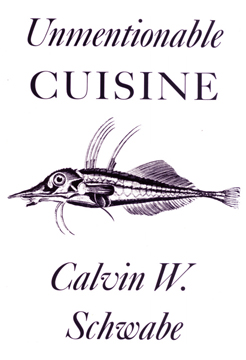RECIPES: And Now For Something Completely Different
 Unmentionable Cuisine includes recipes for dogs and cats as well as tamer items like horsemeat. Perhaps a gift for Father’s Day? Unmentionable Cuisine includes recipes for dogs and cats as well as tamer items like horsemeat. Perhaps a gift for Father’s Day? |
We come from a family that loves to cook—on our mother’s side, we must hastily add. No one wanted to be at Grandma’s (Dad’s mom) too close to dinnertime. Our mother’s mother also hails from Canada, and we have kin in Montreal and Toronto. One of them sent my mother this compendium of rodent recipes, compiled by Bert Christiansen of Toronto, who recalls reading rat recipes in the New York Times during the Nixon administration. With Nixon’s historic trip to China, much cultural exploration ensued, including reports of a restaurant in Beijing that specialized in lemon-fried rat. “When you’re short of protein,” Mr. Christiansen points out, such things start to look tempting. He notes that rich Southerners reportedly ate rats during the Vicksburg siege. Similarly, we recall reading a passage in “Gone With The Wind,” when Scarlett O’Hara told Rhett Butler that she feared she would be reduced to eating rats. He responded that he would rather have a nice, juicy rat than the questionable fare that was being served at his hotel. | |
| In Unmentionable Cuisine, Calvin W. Schwabe notes that “Because of prejudice or ignorance, we Americans now reject many readily available foods that are cheap, nutritious, and good to eat…[and] should be using many forms of protein which are routinely consumed in other parts of the world.” The following excerpts are from a section of the book giving recipes for cooking rats and mice. Brown rats and roof rats were eaten openly on a large scale in Paris when the city was under siege during the Franco-Prussian War. Observers likened their taste to both partridges and pork. And, according to the Larousse Gastronomique, rats are still eaten in some parts of France. In fact, this recipe appears in that famous tome. Grilled Rats Bordeaux Style (Entrecôte à la Bordelaise) Alcoholic rats inhabiting wine cellars are skinned and eviscerated, brushed with a thick sauce of olive oil and crushed shallots, and grilled over a fire of broken wine barrels. In West Africa…rats are a major item of diet. The giant rat (Cricetomys), the cane rat (Thryonomys), the common house mouse and other species of rats and mice are all eaten. According to a United Nations Food and Agricultural Organization report, they now comprise over 50 percent of the locally-produced meat eaten in some parts of Ghana. Between December 1968 and June 1970, 258,206 pounds of cane-rat meat alone were sold in one market in Accra! This is a local recipe that shows the South American influence on West African cuisine. Stewed Cane Rat Skin and eviscerate the rat and split it lengthwise. Fry until brown in a mixture of butter and peanut oil. Cover with water, add tomatoes or tomato purée, hot red peppers, and salt. Simmer the rat until tender and serve with rice.The ancient Romans enjoyed a tasty mouse: Stuffed Dormice Prepare a stuffing of dormouse meat or pork, pepper, pine nuts, broth, asafoetida (a pungent Indian spice made of asafeotida sap, gum arabic, wheat, rice flower and turmeric), and some garum (substitute anchovy paste.) Stuff the mice and sew them up. Bake them in an oven on a tile.Instead of chips with your Margarita, try:Roasted Field Mice (Raton de Campo Asado) / Mexico Skin and eviscerate field mice. Skewer them and roast over an open fire or coals. These are probably great as hors d’oeuvres with margaritas or “salty dogs.” Canadian author Farley Mowat gives this innovative Arctic explorer’s recipe—which sounds much tastier in French: Mice in Cream (Souris à la Crème) Bon appétit! |
||


